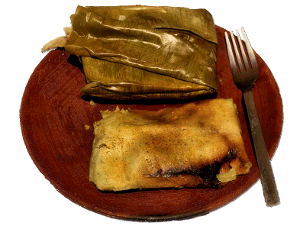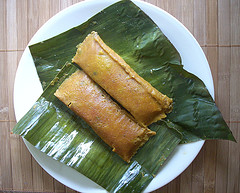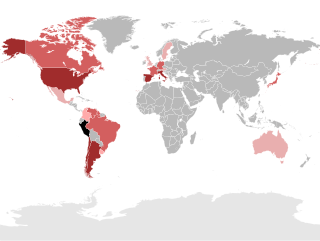
A tamale, in Spanish tamal, is a traditional Mesoamerican dish made of masa, a dough made from nixtamalized corn, which is steamed in a corn husk or banana leaves. The wrapping can either be discarded prior to eating or used as a plate. Tamales can be filled with meats, cheeses, fruits, vegetables, herbs, chilies, or any preparation according to taste, and both the filling and the cooking liquid may be seasoned.

Moyobamba or Muyupampa is the capital city of the San Martín Region in northern Peru. Called "Santiago of eight valleys of Moyobamba" or "Maynas capital". There are 50,073 inhabitants, according to the 2017 census. Some 3,500 species of orchids are native to the area, which has led to the city's nickname of The City of Orchids. The city is the capital of both Moyobamba Province and Moyobamba District.

Loreto is Peru's northernmost department and region. Covering almost one-third of Peru's territory, Loreto is by far the nation's largest department, slightly larger than Japan; it is also one of the most sparsely populated regions due to its remote location in the Amazon Rainforest. Its capital is Iquitos.

Pachamanca is a traditional Peruvian dish baked with the aid of hot stones. The earthen oven is known as a huatia. It is generally made of lamb, mutton, alpaca, llama, guanaco, vicuna, pork, beef, chicken, or guinea pig, marinated in herbs and spices. Other Andean produce, such as potato or chuño, habas, sweet potato, mashua, oca, ulluco, cassava, yacon, plantain, humitas, ears of corn, and chilli, are often included in the baking.
Peruvian cuisine reflects local practices and ingredients including influences mainly from the indigenous population, including the Inca, and cuisines brought by immigrants from Europe, Asia, and Africa. Without the familiar ingredients from their home countries, immigrants modified their traditional cuisines by using ingredients available in Peru.

Tarapoto is a commercial hub town in the San Martín Province of the Department of San Martín of northern Peru. It is an hour by plane from Lima, in the high jungle plateau to the east of what is known as the selva baja. Although Moyobamba is the capital of the region, Tarapoto is the region's largest city and is linked to the Upper Amazon and the historic city of Yurimaguas by a relatively well-maintained transandean highway, paved in 2008–9.

Colombian cuisine is a compound of the culinary traditions of the six main regions within Colombia. Colombian cuisine varies regionally and is particularly influenced by Indigenous Colombian, Spanish, and African cuisines, with slight Arab influence in some regions. As one of the most biodiverse countries in the world, Colombia has one of the widest variety of available ingredients depending on the region.

Ghanaian cuisines refer to the meals of the Ghanaian people. The main dishes of Ghana are organized around starchy staple foods, which goes with either sauce or soup accompanied with a source of protein. The main ingredients for the vast majority of soups and stews are; tomatoes, hot peppers and onions. Most Ghanaian soups and stews are red or orange in appearance as a result of the main ingredients used.

Papas rellenas are the most popular type of croquettes in Latin American regions such as Peru, Ecuador, Bolivia, Mexico, Chile, Colombia, and the Caribbean. The first printed Latin American recipes date to the late 19th century, during a time when French cuisine was influencing the region.

Pasteles, also pastelles in the English-speaking Caribbean, are a traditional dish in several Latin American and Caribbean countries. In Puerto Rico, the Dominican Republic, Venezuela, Panama, Trinidad and Tobago, and the Caribbean coast of Colombia, the dish looks like a tamal. In Hawaii, they are called pateles in a phonetic rendering of the Puerto Rican pronunciation of pasteles, as discussed below.

Chifa is Chinese Peruvian culinary tradition based on Cantonese elements fused with traditional Peruvian ingredients and traditions. The term is also used to refer to restaurants that serve the chifa cuisine.

Peruvians are the citizens of Peru. What is now Peru has been inhabited for several millennia by cultures such as the Caral before the Spanish conquest in the 16th century. Peruvian population decreased from an estimated 5–9 million in the 1520s to around 600,000 in 1620 mainly because of infectious diseases carried by the Spanish. Spaniards and Africans arrived in large numbers in 1532 under colonial rule, mixing widely with each other and with Native Peruvians. During the Republic, there has been a gradual immigration of European people. Chinese and Japanese arrived in large numbers at the end of the 19th century.

Javanese cuisine is the cuisine of Javanese people, a major ethnic group in Indonesia, more precisely the province of Central Java, Yogyakarta and East Java.

Vorí vorí is a thick, yellow soup with little balls made of corn flour, and cheese, and it's traditional of the Paraguayan cuisine. It is essentially of Cario-Guarani and Sephardic origins, and derives from one of the commemorative dishes of the Passover as it derives from the Matza balls, replacing the wheat semolina with the corn flour of the Carios.

Belizean cuisine is an amalgamation of all ethnicities in the nation of Belize and their respectively wide variety of foods. Breakfast often consists of sides of bread, flour tortillas, or fry jacks that are often homemade and eaten with various cheeses. All are often accompanied with refried beans, cheeses, and various forms of eggs, etc. Inclusive is also cereal along with milk, coffee, or tea.

A great variety of cassava-based dishes are consumed in the regions where cassava is cultivated, and the ingredient is included many national or ethnic specialities.

Arroz chaufa, also known as arroz de chaufa, is a fried rice dish from Peru. It is part of the Chinese Peruvian cuisine, which is called chifa.

Carapulcra, or carapulca, is an ancient Andean dish that has been prepared for centuries by both Quechua peoples and Aymara peoples. The original term for this dish in the Aymara language is qala phurk'a, which means a stew made with hot stones. In contemporary Peruvian cuisine and Bolivian cuisine, it is a stew of pork and papa seca, with peanuts, aji panca and mirasol peppers, garlic, and other spices like clove. In ancient times llama meat or alpaca meat would have been used, and some people still use these meats today. It is usually eaten with rice, boiled potatoes or yuca.

Pastil, or pastel, is a Filipino packed rice dish made with steamed rice wrapped in banana leaves with dry shredded beef, chicken, or fish. It originates from the Maguindanaon and is a popular, cheap breakfast meal in Mindanao, especially among Muslim Filipinos. Pastil is also known as patil, patel, patir, or pater in Maranao; and paster in Iranun.



















